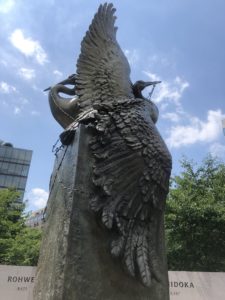In Washington, D.C., for a week recently, I hit many of the high spots: The National Gallery, the Smithsonian Castle, the Botanical Garden, the Vietnam Veterans Memorial.
My hotel was close to Union Station, a grand old railway and now ground transport hub that’s worth visiting if for no other reason than to check out the elegant brass drinking fountains. I’d take side streets down toward the Mall. It was on one of them that I came upon a memorial that touched and moved me at least as much, if not more, than the flashier, more heavily visited sites.
The National Japanese American Memorial to Patriotism During World War II is a beautifully thought-out and designed triangular pocket park located at the intersection of New Jersey Avenue, Louisiana Avenue, and D Street.
A stone’s throw from Capitol Hill, dedicated in 2000, and operated today by the National Park Service, the monument doesn’t loudly proclaim itself (a modest marker with raised metal letters, barely above ground level, marks the “entrance”).
What drew me initially was a mirror-smooth oval reflecting pool: calm, silent, unobtrusive.
Five majestic boulders were meditatively placed. A few sparrows floated serenely on the surface. The configuration of the space — a kind of semicircular nautilus-shaped enclosure — both invites the passerby in and evokes the concept of confinement.
A wall of concave stone panels, each engraved starkly with a name and number, told the story: Poston, 12,814 (Arizona); Heart Mountain, 10,767 (Wyoming); Topaz, 8,130 (Utah); Manzanar, 10,046 (California).
These were four of the 10 major Japanese relocation centers during World War II, names conjuring a shameful chapter of our national history and that, ranged silently beneath the same sun that shone on our founding fathers, stung my eyes.
Above the otherwise empty plaza, on a tall plinth stood two Japanese cranes cast in bronze, their wings majestically unfurled, their beaks grasping the barbed wire with which they were entangled as if to tug themselves free. The cranes nestle with one crane’s wing pointing down, the other raised skyward; their free wings pressed together in support.
Sculptor Nina Akamu’s paternal grandfather was arrested in Hawaii during the war, sent to the Sand Island relocation camp, and died during internment. The golden cranes, struggling for freedom, symbolize prejudice and injustice on the one hand; and longevity, resiliency, and hope on the other. At 14 feet, the sculpture is visible above the granite walls.
The monument honors both those Japanese Americans who were incarcerated during the war and those who faithfully served — many of whom died — in the military during that time. Architect Davis Buckley was the principal designer.

I continued, walking slowly. The elements were stone, water, steel. The colors were gray, black, dull gold. Downtown D.C. was a hubbub; here was a hush.
On the right wall I read:
“On February 19, 1942, 73 days after the United States entered World War II, President Franklin D. Roosevelt issued Executive Order 9066 which resulted in the removal of 120,000 Japanese American men, women, and children from their homes in the western states and Hawaii.”
The families, allowed to bring only what they could carry, were forced to abandon homes, businesses, and friends. The remote relocation centers to which they were transported were essentially prisons, patrolled by armed guards, surrounded by barbed wire. Some stayed until March, 1946.
Less well known is that more than 33,000 Japanese Americans served in the military during that time. In fact, “the 100th infantry battalion and 442nd regimental combat team, fighting in Europe, became the most highly decorated army unit for its size and length of service in American Military History.” In 1983, the federal Commission on Wartime Relocation and Internment of Civilians found that there had been no military necessity for the mass imprisonment.
In 1988, President Ronald W. Reagan signed the Civil Liberties Act.
Inscribed on the pool edge are his words at the time: “Here we admit a wrong. Here we affirm our commitment as a nation to equal justice under the law.”
In addition to apologizing for the gross injustice, the government awarded reparations in the amount of $20,000 apiece to more than 82,000 Japanese American camp survivors.
A poem on the rear wall entitled “The Legacy” by Akemi Matsumoto Ehrlich, reads:
Japanese by blood
Hearts and minds American
With honor unbowed
Bore the sting of injustice
For future generations.
Five additional panels of names honor the more than 800 Japanese Americans who died in service to their country during World War II.
You can sit on a bench by these names and watch the sparrows, quietly twittering and splashing on the pool. You can ponder the five huge rocks, representing the five generations of Japanese Americans living at the time the memorial was established. Chances are you’ll be by yourself.
You can think about what the memorial doesn’t say, what it doesn’t demand, what it holds back. A wound without self-pity or rage; an insistence on remembering, but not on resenting; a desire, in spite of the hurt, to contribute.
You could study those two entwined cranes, wings raised to the sky.
You might ponder the words of Mike M. Masaoka, civil rights advocate and staff sergeant at the 442nd Regimental Combat Team: “I am proud that I am an American of Japanese ancestry. I believe in this nation’s institutions, ideals and traditions. I glory in her heritage. I boast of her history. I trust in her future.”

